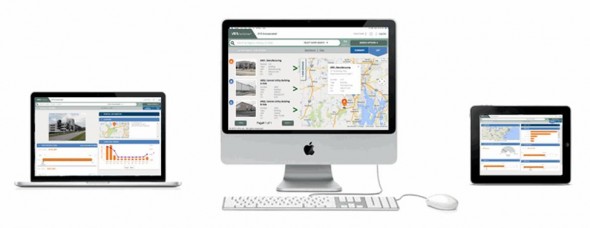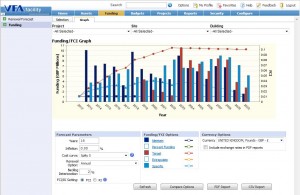Capturing and analysing data about existing built assets is being enabled by mobile and SaaS technologies. VFA is now competing in the UK market.
While much of the UK debate about building information modelling has been about accommodating the varying needs of people involved in the design and construction phases of an asset’s lifecycle, only in the last year or so has there been deeper discussion of the owner/operator’s longer-term asset information requirements. The publication of PAS1192 Part 3 in March 2014 has helped with this (as have various conferences covering operation and maintenance needs – thinkBIM in Leeds on 9 July returned to the topic for a third time), and I think the industry is also beginning to understand that BIM can also be retrospectively applied to existing buildings and other facilities.
This is a central argument made by Kykloud‘s Ed Bartlett, among others, who argues that design geometry is just part of the information needed to run capital assets (post). Powerful Software-as-a-Service data aggregation, analysis and reporting toolsets can help owners and facility managers make informed decisions about their assets, and US-based VFA is now providing facilities assessments, using “cloud-based software with analytic tools that drive actionable capital plans” in the UK.
VFA
![]()
 Over the past 15 years since it was founded in Boston, VFA has shown over 800 organisations how to ensure that their facilities optimally support their strategic business objectives, helping reduce risk, lower costs, improve service quality and customer satisfaction, and satisfy compliance requirements. Its facilities assessments are tailored to organisational needs, and can be delivered online by VFA’s or the client’s staff. VFA has now started growing a Reading-based UK business, managed by Chris Low. Formerly EMEA sales and key accounts manager at MRI Software, and with a background in property consultancy services, Chris explained to me how VFA’s suite of software tools can be used.
Over the past 15 years since it was founded in Boston, VFA has shown over 800 organisations how to ensure that their facilities optimally support their strategic business objectives, helping reduce risk, lower costs, improve service quality and customer satisfaction, and satisfy compliance requirements. Its facilities assessments are tailored to organisational needs, and can be delivered online by VFA’s or the client’s staff. VFA has now started growing a Reading-based UK business, managed by Chris Low. Formerly EMEA sales and key accounts manager at MRI Software, and with a background in property consultancy services, Chris explained to me how VFA’s suite of software tools can be used.
- First, he said, data is collected through a cloud-based guided self-assessment solution, VFA.auditor, that creates surveys to rapidly collect facility and building condition data via an iPad or Android tablet. Users can collate wide-ranging asset information including location, structure, type, uses, conditions, requirements and associated costs, and related projects and plans.
- Next, that data can be imported into VFA.facility, a cloud-based configurable dashboard solution for facilities capital planning and management which helps facility managers, capital planners, financial analysts and executives visualise their data and make optimal decisions about facility spending, sustainability investments and capital planning.
- Real estate data from VFA.facility can also be quickly and securely shared with selected stakeholders, via a further application, VFA FacilityView.

- Asset information can also be integrated, via AssetFusion, with information held in computerised maintenance management systems such as IBM’s Maximo.
The VFA tools thus enable users to quickly and easily search for assets meeting certain criteria, see summary statistics about a selected assets, view locations on a map, and dive into key asset details, including requirements by priority, category or system.
In the UK, Chris told me VFA is successfully winning work from large PFI stakeholders, in market sectors such as healthcare, and with major owners of distributed assets. He also highlighted that the VFA product suite wasn’t just about buildings but included a module for linear and infrastructure assets (steam, water, electrical distribution systems, sanitary and storm sewers, carparking, pedestrian paving, etc).
What-if scenario planning
 With Chris’s VFA colleague, director of product marketing David Isaacson, we also looked at how the system uses industry-standard Facility Condition Index metrics to set targets for investment programmes. VFA uses CIBSE-defined standard condition ratings, and BCIS cost data to define the lifecycle costs for each system in a building, and calculates the FCI (calculated by taking the capital needs and dividing by the replacement value of the building – see Wikipedia article); the lower the FCI value, the better the condition of the building. With this information, clients can calculate how much funding will be required to achieve a particular FCI, and scenarios can be defined that show – scientifically, transparently and defensibly – the impact of different funding levels.
With Chris’s VFA colleague, director of product marketing David Isaacson, we also looked at how the system uses industry-standard Facility Condition Index metrics to set targets for investment programmes. VFA uses CIBSE-defined standard condition ratings, and BCIS cost data to define the lifecycle costs for each system in a building, and calculates the FCI (calculated by taking the capital needs and dividing by the replacement value of the building – see Wikipedia article); the lower the FCI value, the better the condition of the building. With this information, clients can calculate how much funding will be required to achieve a particular FCI, and scenarios can be defined that show – scientifically, transparently and defensibly – the impact of different funding levels.
Capital needs prioritisation
 VFA also helps clients decide where, when, and how much to invest by demonstrating that these investments align with the their objectives. VFA’s Capital Budgeting and Ranking Module allows clients to develop multiple strategies to assess different prioritisation approaches. These strategies can include data elements beyond condition, assessing, say, how mission-critical the asset is, what the risk and impact of failure might be, and how well the asset meets the client’s functional needs. Pair-wise analysis processes are deployed, testing the relative importance of individual items in order to achieve an overall rank ordering.
VFA also helps clients decide where, when, and how much to invest by demonstrating that these investments align with the their objectives. VFA’s Capital Budgeting and Ranking Module allows clients to develop multiple strategies to assess different prioritisation approaches. These strategies can include data elements beyond condition, assessing, say, how mission-critical the asset is, what the risk and impact of failure might be, and how well the asset meets the client’s functional needs. Pair-wise analysis processes are deployed, testing the relative importance of individual items in order to achieve an overall rank ordering.
As a result, strategies can be developed to rank all capital needs with budget as an overall constraint. This helps ‘depoliticise’ prioritisation decisions, helps clients develop different strategies for different projects, different parts of the estate, and different investment objects, and allows multiple objectives to be met while making sure that the most important issues are addressed in a timely fashion.







1 ping
[…] blog, written by Paul Wilkinson. Paul covers VFA’s presence in the UK market in his post, ‘VFA enters UK SaaS asset management market.’ You can also connect with VFA’s Business Director in the UK, Chris […]